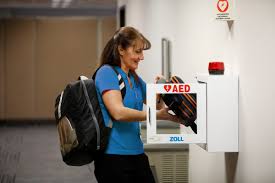Keeping AEDs Rescue-Ready: Inspection, Troubleshooting, and Why is it Beeping?
Automated External Defibrillators (AEDs) are essential lifesaving tools—silent sentinels waiting for the moment they’re needed most. But ensuring they’re always ready isn’t just a matter of plugging them in and forgetting about them. One of the most common questions we get as AED program providers is, “How do I inspect my AED?” Like fire extinguishers or first aid kits, AEDs require regular inspections and upkeep to function properly in an emergency.
According to organizations like the American Heart Association (AHA) and OSHA, following industry best standards of practice for AED maintenance isn’t optional—it’s critical. These standards provide guidelines on how often to inspect devices, what to look for, and how to document everything for compliance and safety assurance.
One of the most common maintenance issues AED owners encounter is a beeping device. That persistent beep is the AED’s way of saying, “Hey, something’s not right.” Whether it’s a low battery, expired pads, or a failed self-test, ignoring the sound can mean the difference between a working AED and a useless one when every second counts.

Industry Best Standards of Practice for Inspecting AEDs
AED inspection and maintenance isn’t just a best practice—it’s often a legal requirement depending on your location. Following industry-recognized standards ensures your device stays in optimal condition and is rescue-ready when needed. Here’s what the leading health and safety organizations recommend:
1. Follow a Regular Inspection Schedule
- Weekly or Monthly Checks: Most manufacturers and safety agencies, such as the American Heart Association (AHA) and Occupational Safety and Health Administration (OSHA), recommend at least monthly inspections.
- Post-Use Checks: Always inspect the AED after any use to confirm that new pads and batteries are installed and the device passes self-tests.
2. Use a Standardized Checklist
Create or download an AED inspection checklist to streamline and document the process. A typical checklist includes:
- ✔️ Visual status indicator check (green light, check mark, or OK sign depending on model)
- ✔️ Battery installation and expiration date
- ✔️ Pad cartridge presence and expiration date
- ✔️ No visible damage to unit or accessories
- ✔️ Clean, dry, and accessible storage
Your AED user manual will include a list a model specific inspection questions.
3. Maintain Detailed Records
Keep logs of all inspections, maintenance, and battery/pad replacements. These records:
- Help ensure compliance with legal requirements
- Are critical for workplace safety audits or post-incident reviews
- Can be digital (via AED management software) or physical (in a binder near the AED) Check out our AED Navigator Program for automated inspection reminders and digital record keeping.
4. Verify Automated Self-Test Results
Most modern AEDs perform daily, weekly, or monthly self-tests, checking:
- Battery charge
- Pad connectivity
- Internal circuitry
- Software integrity
Best practice: Don’t solely rely on the self-test. Combine it with manual inspection to catch physical or environmental issues the AED can’t detect (e.g., water damage, tampering).
5. Use Manufacturer-Approved Parts
Always replace batteries and pads with components specifically approved by the AED manufacturer. Using third-party parts can:
- Void warranties
- Fail during an emergency
- Cause self-test failures or persistent alerts
6. Integrate AED Checks with Workplace Safety Protocols
If you’re in a facility with a formal safety plan (e.g., a school, factory, gym, or office), ensure AED inspections are:
- Assigned to trained individuals
- Part of your emergency response drills
- Reviewed annually as part of safety audits
A section about performing and documenting AED inspections and tests should be included in your standard written Policies & Procedures. As mentioned, be sure to review these annually!
Why is my AED Beeping? – What to do next
Automated External Defibrillators (AEDs) are critical lifesaving devices, but like any technology, they can sometimes signal issues through beeping sounds. Understanding these alerts is vital for ensuring the device is ready when needed. Next, we will walk through common beeping scenarios across popular AED models, and how to troubleshoot.
1. Why is my Cardiac Science Powerheart® G5 Beeping?
The Powerheart G5 has the most advanced level of self-testing, which is set by default to be done daily. The AED will not only test itself the the standard things like; battery life, presence of installed electrodes, and software status; it will also look at installed pads ecpiration date, condition on the adhesive component of the pads, and whether the pads packaging is opened.
Troubleshooting Steps:
- Check battery life symbol: A low battery is one of the most common causes for beeping. If your AED has a low battery, it’s important to replace it as soon as possible
- Open lid of AED and Ensure pads are installed: Unplug and re-install electrode pads.
- Check Expiration Date of the installed pads: These pads have a smart chip, which tells the AED when they expire and will cause both a red X in the status indicator window as well as beeping.
- Check pads packaging for openings or tears: Opened electrode pads constitute critical maintenance need, as the adhesive component will quickly dry out.
- If available, try installing another set of elctrode pads to rule out any problems with the condition of the pads. If your AED has been stored outdoors or in a car, it’s prossible that the pad condition has deteriorated.
- Contact Support: If the problem persists, contact Cardiac Science with the device’s serial number for further assistance.
2. Why is my ZOLL AED Plus Beeping?
Beeping Cause: A red “X” in the indicator window accompanied by beeping suggests a failed self-test, expired batteries, or missing electrode pads.
Troubleshooting Steps:
- Press and hold power button for 10 seconds: This initiates a self-test. If the issue is battery related, the AED will say, “Unit Failed, Replace Batteries”.
- Check Electrode Pads: Ensure the pads are properly connected. Unplug and re-install pads. Ensure there are no breaks or tears in the wires.
- Try new pads: If available, try installing a new set of pads to rule out pads connector issues.
- Contact Support: If issues persist, it’s likely a software or parts problem. contact ZOLL Technical Support at 1-800-348-9011.
3. Why is my Philips HeartStart FRx Beeping?
The Philips FRx AED uses visual and audible indicators to communicate its status. If your device is beeping, consider the following:
Common Causes of Beeping:
- Self-Test Error: A flashing “i” button accompanied by chirping indicates a self-test failure.
- Battery Issues: A missing, improperly installed, or depleted battery can prevent the device from passing its self-test.
- Electrode Pad Problems: Issues such as expired, damaged, or improperly connected pads can trigger alerts.
- Child/Infant Key Left Installed: If the child/infant key is left in the device after use, it can cause errors during subsequent self-tests.defibshop.co.uk
Troubleshooting Steps:
- Check the “i” Button: If flashing, press it to hear the specific error message.
- Inspect the Battery: Ensure it’s correctly installed and not expired. Replace if necessary.
- Examine the Electrode Pads: Verify they are within their shelf life, properly connected, and not damaged.
- Remove the Child/Infant Key: Ensure it’s not installed unless needed for pediatric use.
- Run a Self-Test: After addressing any issues, initiate a self-test to confirm the device is ready for use.
For more detailed guidance, refer to the Philips FRx Troubleshooting Guide.
Why is my LIFEPAK CR2 Beeping?
he LIFEPAK CR2 AED uses a Readiness Indicator and audible tones to communicate its status. If your device is beeping, consider the following:
Common Causes of Beeping:
- Non-Flashing Readiness Indicator: Indicates the device needs attention.
- Battery Issues: An expired or improperly installed battery can prevent the device from being ready.
- Electrode Tray Problems: Expired, used, or improperly installed electrode trays can trigger alerts.
Troubleshooting Steps:
- Check the Readiness Indicator: If it’s not flashing every 6 seconds, the device needs attention.
- Inspect the Battery: Ensure it’s correctly installed and not expired. Replace if necessary.
- Examine the Electrode Tray: Verify it’s within its shelf life, properly installed, and not damaged.
- Perform a Manual Check: Open the lid and press and hold the LANGUAGE and CHILD MODE buttons simultaneously until you hear either “DEVICE READY” or “DEVICE NOT READY.” Follow the voice prompts for further instructions.
For more detailed guidance, refer to the LIFEPAK CR2 Troubleshooting Guide.
Final Thoughts: Keeping Your AED Ready to Save Lives
An AED is only as reliable as its last inspection. Whether it’s sitting in a school hallway, office building, gym, or public park, this life-saving device must be ready to perform without hesitation. But too often, AEDs are forgotten until an emergency occurs—and by then, a missed inspection can lead to deadly delays.
Throughout this guide, we’ve looked at common beeping alerts and specific troubleshooting steps for popular models like the Powerheart G5, ZOLL AED Plus, Philips FRx, and LIFEPAK CR2. While each device has its own indicators and quirks, one thing remains constant across all brands: routine inspections are essential.
Following industry best standards of practice—like conducting monthly checks, verifying battery and pad expiration dates, and keeping accurate records—ensures that your AED won’t just look ready; it will be ready. Ignoring even minor alerts like a soft chirp or a blinking light can compromise the device’s ability to function when seconds count.
Incorporating AED inspections into your workplace or facility’s safety routine is one of the simplest, most effective ways to protect lives. It’s not just maintenance—it’s peace of mind, knowing that in a crisis, your AED will respond as it should.
Because in a sudden cardiac arrest, the best AED is the one that works. And the one that works is the one that’s been inspected.

